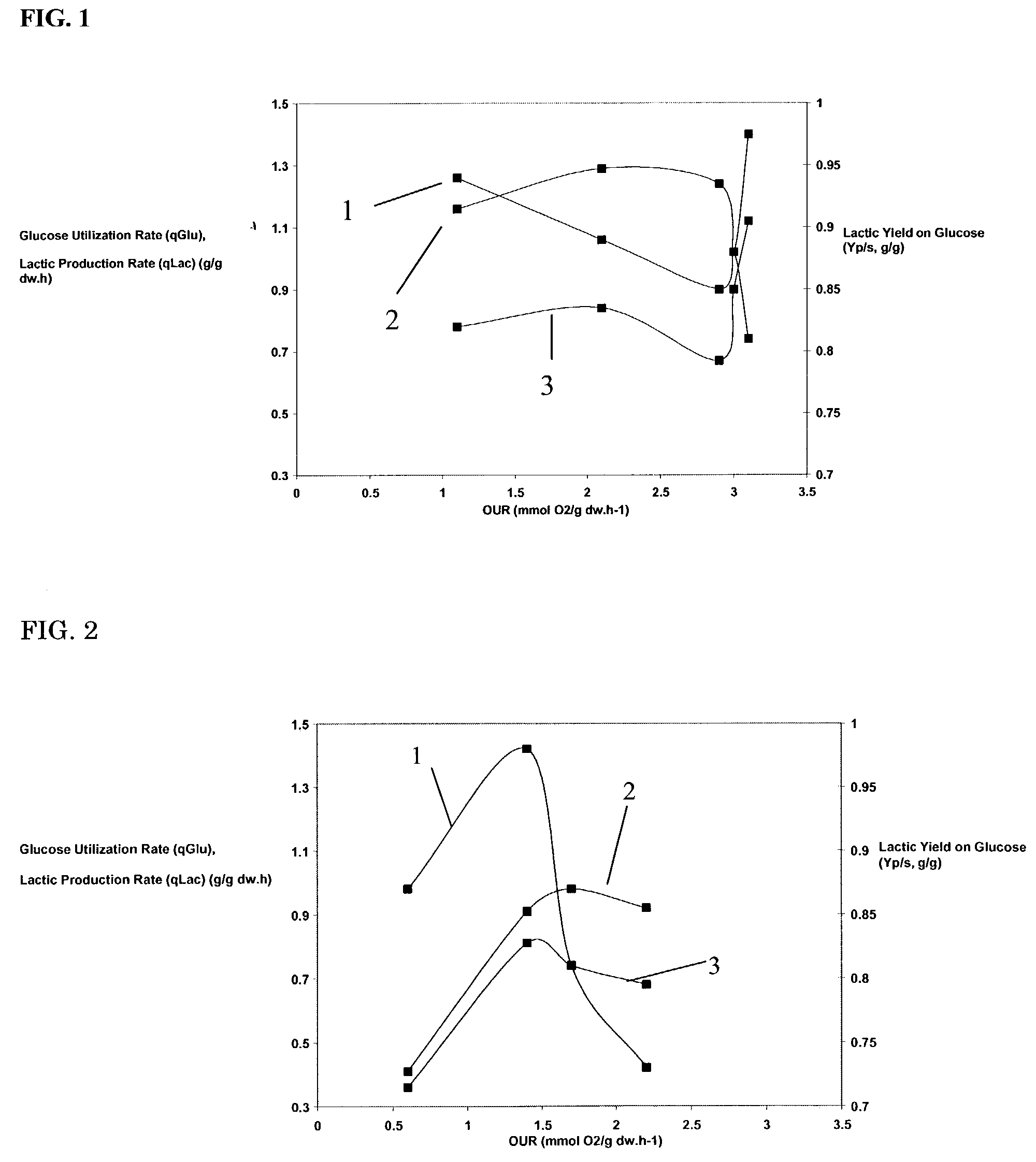Fermentation process using specific oxygen uptake rates as a process control
a technology of specific oxygen uptake and process control, which is applied in the direction of biofuels, bulk chemical production, instruments, etc., can solve the problems of strains that did not perform nearly well enough for implementation in any commercial process, increase raw material costs, and increase the cost of raw materials, etc., to achieve high yield, optimize the fermentation process, and improve the effect of production ra
- Summary
- Abstract
- Description
- Claims
- Application Information
AI Technical Summary
Benefits of technology
Problems solved by technology
Method used
Image
Examples
example 1
[0053]An inoculation stock of an engineered yeast cell designated CD 587 is prepared in a 250 ml shake flask containing 100 ml CaCO3-buffered (42 g / l) yeast extract (10 g / l)-peptone (20 g / l) medium with 100 g / l glucose. At OD600=10, the cells are harvested by centrifugation and subsequently resuspended in 15% (w / v) glycerol solution and stored in 1.5 mL aliquots at −80° C.
[0054]Cell CD 587 is a K. marxianus cell having its PDC gene deleted and an exogenous L. helveticus D-LDH gene integrated into its genome at the site of the deleted PDC gene, under the control of native PDC promoter and terminator sequences. Cell CD 587 and its preparation are described more fully in U.S. Provisional Application No. 60 / 384,333, filed May 30, 2002.
[0055]The growth phase is started by inoculating a 3 L fermenter with one 1.5 mL glycerol stock, resulting in an initial OD600 of 0.05. The growth phase is run aerobically by continually sparging air at a flow rate of 1.5 L / min (0.5 vvm) at a constant stir...
example 2
[0059]Example 1 is repeated several times using a strain designated CD 558. Strain CD 558 is a K. marxianus cell having its PDC gene deleted. It contains an exogenous L. helveticus D-LDH gene randomly integrated into its genome. The LDH gene is under the control of a S. cerevisiae PGK-1 promoter and S. cerevisiae Gal-10 terminator sequences. In each run, OUR in the growth phase is about 20.5 mmol O2 / gdw / hr. Aeration conditions during the production phases are varied from run to run by controlling sparging and stirring rates, in order to vary OUR. OUR values for the different runs are about 0.6, 1.4, 1.7 and 2.2. At a production phase OUR of 1.7, results are as shown in Table 2:
[0060]
TABLE 2Maximum Lactic Acid Titer 111 g / kgGlucose Consumption Rate0.94 g / gdw / hLactic Acid Production Rate0.83 g / gdw / hYield to Lactic Acid (production phase)0.89 g Lactic Acid / g Glucose% Carbon Recovered (production phase)95.6Optical Purity of the Lactic Acid>99.9
[0061]FIG. 2 illustrates how varying OUR af...
example 3
[0062]Example 1 is repeated three times. The first of these runs (3A) is conducted as described in Example 1, except OUR during the production phase is 2.1 mmol O2 / gdw / h. During the second of these runs (3B), the culture is switched to production phase immediately when the DO during the growth phase reaches zero. OUR is 1.8 mmol O2 / gdw / h, under the same aeration conditions as Example 3A. In the third run (3C), aeration is continued at the end of the growth phase for over 1.5 hours after the DO reaches zero, and the OUR in the production phase is 1.4 mmol O2 / gdw / h under the same aeration conditions as Example 3A. Results are summarized in Table 3
[0063]
TABLE 3Example No.Property3A3B3CHolding time, zero DO1 hr0>1.5 hrOUR, production phase (mmol / gdw / h)2.11.81.4Maximum Lactic acid titer (g / kg)112.38494Glucose consumption rate (g / gdw / h)1.221.060.40Lactate production rate (g / gdw / h)1.200.930.32Yield Lactic acid (production phase, g / g)0.890.840.79% carbon recovery (production phase)105104.39...
PUM
| Property | Measurement | Unit |
|---|---|---|
| time | aaaaa | aaaaa |
| freezing temperature | aaaaa | aaaaa |
| temperatures | aaaaa | aaaaa |
Abstract
Description
Claims
Application Information
 Login to View More
Login to View More - R&D
- Intellectual Property
- Life Sciences
- Materials
- Tech Scout
- Unparalleled Data Quality
- Higher Quality Content
- 60% Fewer Hallucinations
Browse by: Latest US Patents, China's latest patents, Technical Efficacy Thesaurus, Application Domain, Technology Topic, Popular Technical Reports.
© 2025 PatSnap. All rights reserved.Legal|Privacy policy|Modern Slavery Act Transparency Statement|Sitemap|About US| Contact US: help@patsnap.com

